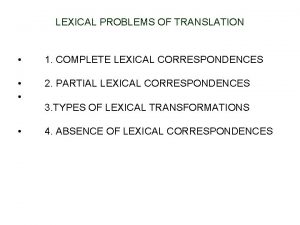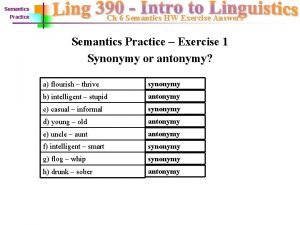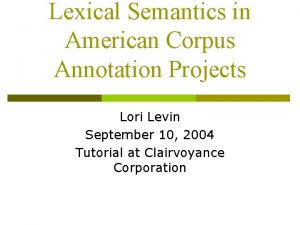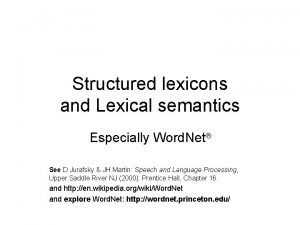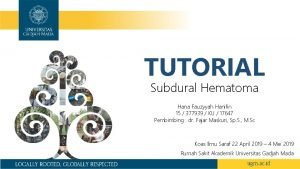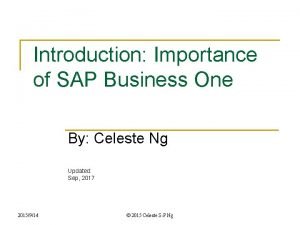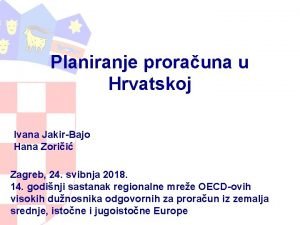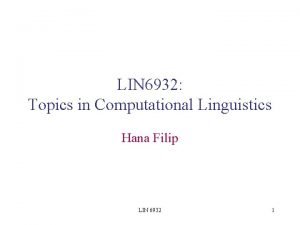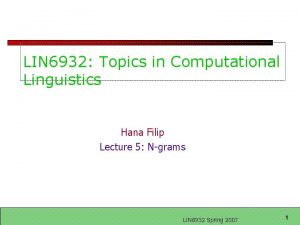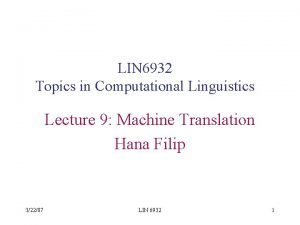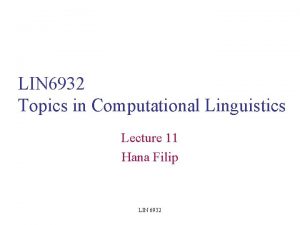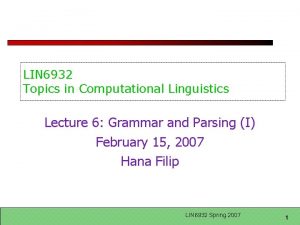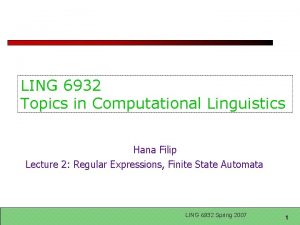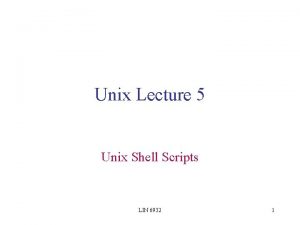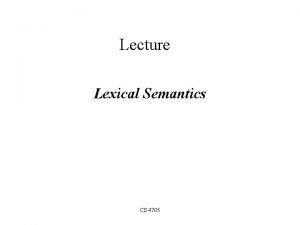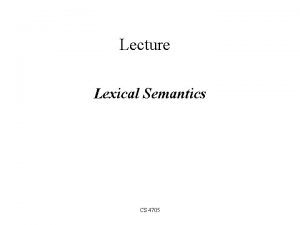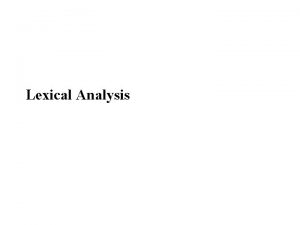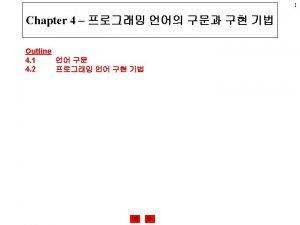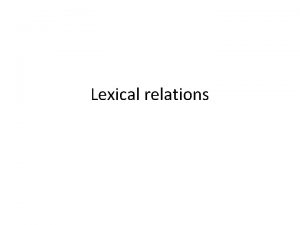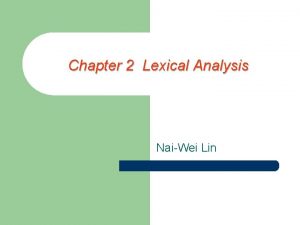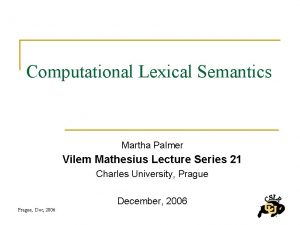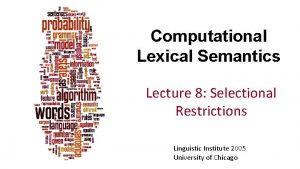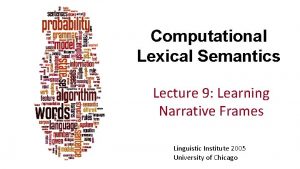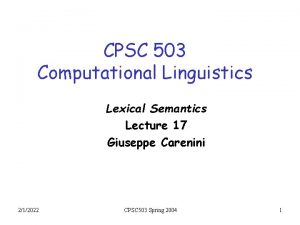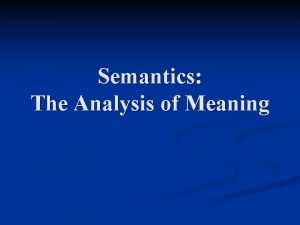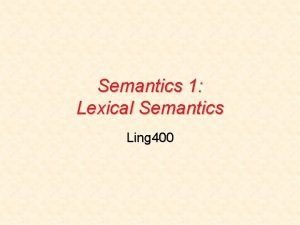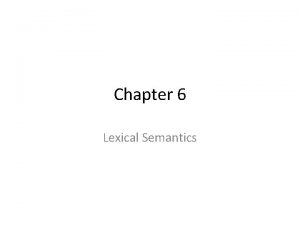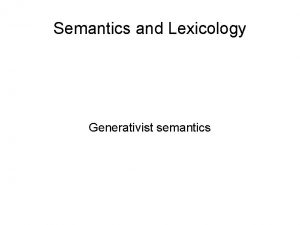LIN 6932 Lecture 10 Computational Lexical Semantics Hana



























- Slides: 27

LIN 6932 Lecture 10: Computational Lexical Semantics Hana Filip 12/30/2021 LIN 6932 1

Meaning • Traditionally, meaning in language has been studied from three perspectives – The meanings of individual words – How those meanings combine to make meanings for individual sentences or utterances (compositional semantics) – How those meanings combine to make meanings for a text or discourse (discourse semantics) • We are going to focus today on word meaning, also called lexical semantics. 12/30/2021 LIN 6932 2

Outline: Comp Lexical Semantics • Intro to Lexical Semantics – Homonymy, Polysemy, Synonymy – Online resources: Word. Net • Computational Lexical Semantics – Word Sense Disambiguation • Supervised • Semi-supervised – Word Similarity • Thesaurus-based • Distributional 12/30/2021 LIN 6932 3

Preliminaries • What’s a word? – Notions we’ve used so far: Types, tokens, stems, roots, inflected forms, etc. . . – Lexeme: An entry in a lexicon consisting of a pairing of a form with a single meaning representation 12/30/2021 LIN 6932 4

Lexeme • Lexeme – a pairing of a form with a sense • Orthographic form – the way the lexeme looks on the page • Phonological form – the way the lexeme sounds • Lexicon – finite list of lexemes eaten eat Lexeme eat ate 12/30/2021 LIN 6932 5

Lexical Relations: Relationships between word meanings • • Homonymy Polysemy Synonymy Hypernymy Meronymy Antonymy 12/30/2021 LIN 6932 6

Homonymy A relation that holds between two lexemes that have the same form (phonological, orthographic or both) with unrelated meanings • Homophones right - write piece - peace • Homographs bass (fish) - bass (guitar) • Homographs (and also homophones) Bat (wooden stick-like thing) Bat (flying scary mammal thing) Bank (financial institution) Bank (riverside) 12/30/2021 LIN 6932 7

Homonymy A relation that holds between two lexemes that have the same form (phonological, orthographic or both) with unrelated meanings Example: BANK sloping mound Lexeme bank Lexeme 12/30/2021 LIN 6932 Financial institution 8

Homonymy causes problems • Spelling correction – Confusables – your vs. you’re • Speech recognition – Homophones and pure homonyms • Text-to-speech – Homographs (same orthographic form but different phonological form) • bass vs bass • Information retrieval – Homographs and pure homonyms (different meanings but same orthographic form) • QUERY: bat care 12/30/2021 LIN 6932 9

Polysemy a single lexeme has multiple related meanings While some banks furnish sperm only to married women, others are less restrictive. I withdrew the money from the bank. The bank is constructed from red brick. Biological repository bank Lexeme Financial institution 12/30/2021 LIN 6932 10

Polysemy • A single lexeme with multiple related meanings (bank the building, bank the financial institution) • Most common words have multiple meanings – The number of meanings is related to its frequency – Verbs tend more to polysemy 12/30/2021 LIN 6932 11

Specific types of polysemy: Metaphor and Metonymy • Metaphor: – Sally is cold as ice. – The relationship is on the rocks. • Metonymy – The White House announced its decision yesterday. – Shakespeare takes up 5 feet of my bookshelves. 12/30/2021 LIN 6932 12

Metaphor • Metaphors help us understand one domain of experience (typically some abstract domain) in terms of another (typically a concrete domain). Sally is a block of ice is easy to understand but Sally is a table is odd. The reason is that • we systematically and ‘habitually’ understand the domain of interpersonal relationships in terms of temperature. 12/30/2021 LIN 6932 13

Metaphor • Time understood in terms of space The end of semester is coming upon us. 12/30/2021 LIN 6932 14

Metonymy The use of one concept (domain) to refer to another concept (domain) whereby both belong to the same encompassing experiential (superordinate) domain PRODUCER FOR PRODUCT • I’ll have an Anchorsteam. AUTHOR FOR WORKS • He likes Shakespeare. PLACE FOR INSTITUTION (people who constitute that institution) • The White House had no comment. OBJECT USED FOR THE USER • The gun he hired wanted fifty grand. PART FOR WHOLE • 12/30/2021 We don’t hire skinheads. LIN 6932 15

How do we know when a word has more than one sense? • airline examples Which flights serve breakfast? Does Delta serve Philadelphia? • The “zeugma” test/effect: ? Does United serve breakfast and San Jose? • Distinct meanings of an ambiguous lexeme (homophone, homograph) can give rise to the zeugma effect - ‘oddity’ 12/30/2021 LIN 6932 16

How do we know when a word has more than one sense? The “zeugma” test/effect: ? Does Delta serve breakfast and San Jose? Coordination construction with ellipsis Does Delta serve breakfast and <does Delta serve> San Jose? 1. Syntactic constraint on the coordinands (units) in a coordination construction: they are typically of the same syntactic category: e. g. , V, VP, clause, etc. 2. Semantic constraint: If a part of the second coordinand is elided, it must be interpreted in a parallel (ideally identical) fashion with the first coordinand. 3. Hence, due to the parallelism, the choice of a reading for ‘serve’ in the first coordinand determines the reading of the understood ‘serve’ in the second elided constituent. The choice of a distinct meaning of the ambiguous lexeme ‘serve’ gives rise to a zeugma effect in the above example 12/30/2021 LIN 6932 17

How do we know when a word has more than one sense? Another example: ? John took some money out of his savings and then a vacation. The corresponding (understood) not elided coordination construction: ? John took 1 some money out of his savings and then he took 1 a vacation. 12/30/2021 LIN 6932 18

How do we know when a word has more than one sense? Yet another example: Zeugma test and VP anaphora (1) John saw a mole and so did Bill. The corresponding (understood) coordination construction (2) John saw a mole and Bill saw a mole. Due to the parallelism, the choice of a reading for ‘a mole’ in the first coordinand determines its reading in the second VP in (2), and also in the corresponding VP anaphor ‘so did’ in (1) 12/30/2021 LIN 6932 19

How do we know when a word has more than one sense? • Distinct meanings of a polysemous lexeme (homophone, homograph) do NOT give rise to zeugma effects - ‘oddity’ Pick up the glass 1, and pour it 1 into the pitcher. (example from Green 1989, p. 48) • Here, different meanings of a single polysemous lexeme ‘glass’ (container, content) are used in different clauses without oddity 12/30/2021 LIN 6932 20

Synonymy • Two lexemes are synonyms if they can be successfully substituted for each other in all situations without changing the content of a whole sentence (preservation of truth conditions) • Some words that have the same meaning in some contexts. – – – filbert youth big automobile couch soda hazelnut adolescent large car sofa pop • There are probably no exact synonyms What are some differences between “big” and “large”? 12/30/2021 LIN 6932 21

Synonymy How big is that plane? How large is that plane? A big fat apple ? A large fat apple a big brother a large brother older big lexeme Positive size large 12/30/2021 lexeme LIN 6932 22

Hyponymy A relation that hold between two lexemes where one denotes a subclass of the other vehicle car • ontology • taxonomy • object hierarchy 12/30/2021 hypernym vehicle hyponym car LIN 6932 23

Hyponymy • What is hyponymy? • Not symmetric – Example: car is a hyponym of vehicle and vehicle is a hypernym of car – Test: That is a car implies That is a vehicle (but not vice versa) • What is an ontology? – Ex: CAR#1 is an object of type car • What is a taxonomy? – Ex: car is a kind of vehicle. CAR#1 is an object of type car • What is an object hierarchy? 12/30/2021 LIN 6932 24

Resources • There are lots of lexical resources available these days… – Word lists – On-line dictionaries – Corpora • The most ambitious one is Word. Net – A database of lexical relations for English • Versions for other languages are under development 12/30/2021 LIN 6932 25

Word. Net Relations 12/30/2021 LIN 6932 26

Word. Net Hierarchies 12/30/2021 LIN 6932 27
 Computational lexical semantics
Computational lexical semantics Types of lexical correspondences
Types of lexical correspondences Semantic exercise
Semantic exercise Lexical semantics
Lexical semantics Lexical semantics
Lexical semantics Lexical meaning in semantics
Lexical meaning in semantics Compare procedural semantics and declarative semantics.
Compare procedural semantics and declarative semantics. 01:640:244 lecture notes - lecture 15: plat, idah, farad
01:640:244 lecture notes - lecture 15: plat, idah, farad Hana motors
Hana motors Sap s4 hana automotive
Sap s4 hana automotive Hana gawlasova
Hana gawlasova Sap hana analysis process
Sap hana analysis process Alifa hana syahrani
Alifa hana syahrani Hana slivkova
Hana slivkova Samim
Samim Prebuilt hana views
Prebuilt hana views Crystal bridge snp
Crystal bridge snp Hana brixi
Hana brixi Hana hanifan
Hana hanifan Hana bold
Hana bold Sap hana hint
Sap hana hint Hana zoričić
Hana zoričić Sap hana tdi phase 5
Sap hana tdi phase 5 Qa cheat sheet
Qa cheat sheet Sap json
Sap json S4 hana finance training
S4 hana finance training Hana korać
Hana korać Hana data provisioning
Hana data provisioning

